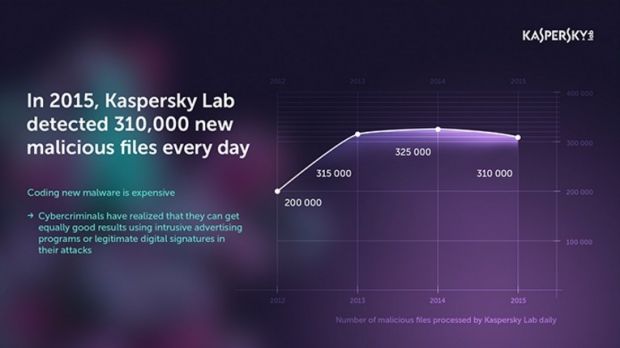During 2015, telemetry data from various of Kaspersky security products has revealed that the daily malware count has gone down from 325,000 a day to 310,000.
Unfortunately, for us, regular computer users, the malware's efficiency was much higher than the previous year, and the number of infected machines went up by 5% compared to 2014.
There a few reasons this happened, and most of the causes have to do with the malware market's saturation as far as new malicious code is concerned, as Kaspersky security experts explain.
Underground malware shops have helped saturate the market
Because the underground malware black market has matured so much in recent years, it is now much easier and faster to buy malicious code online, rather than hire programmers to write new one.
Furthermore, with the proliferation of stolen digital certificates on the underground market, it has now become much easier to sign malicious code and have it pass as a legitimate application.
This tactic has removed the need for complex malware, since it's no longer necessary to fool antivirus solutions, and previous tools that were deemed unsafe can be very efficient once again if digitally signed.
"Cybercrime has lost the last touch of romance," said Vyacheslav Zakorzhevsky, Head of Anti-Malware Team at Kaspersky Lab. "Today, malware is created, bought and resold for specific tasks. The commercial malware market has settled, and is evolving towards simplification."
Kaspersky's predictions for 2016
While the malware landscape has changed in 2015 as compared to 2014, if we're to believe Kaspersky, 2016 won't look like 2015 either.
According to a series of predictions its security analysts have published in one of their end-of-the-year reports, in 2016, the Russian-based antivirus company is getting ready to see an increase in malware targeting financial transactions, along with a rise in the number of ransomware families.
As a general trend for 2016, Kaspersky expects to see malware operators focus their efforts on any action that might help them pocket more money. This includes ransomware, as mentioned above, and extortion attempts, either via looming DDoS attacks or by stealing information in data breaches and holding it for ransom.
We can already see a rise in these types of attacks, as criminals haven't been willing to wait for 2016 to make Kaspersky's predictions come true, with some group already changing gears during the last few months of 2015.

 14 DAY TRIAL //
14 DAY TRIAL // 

